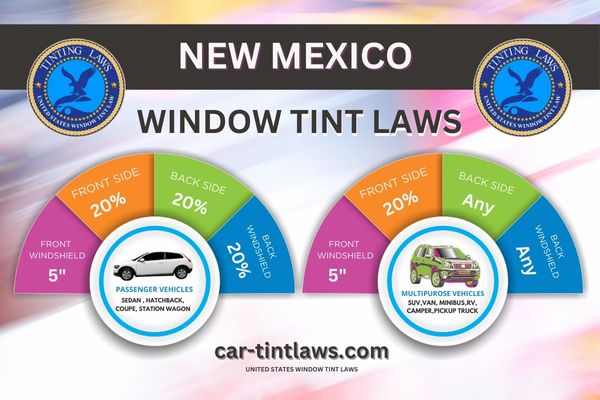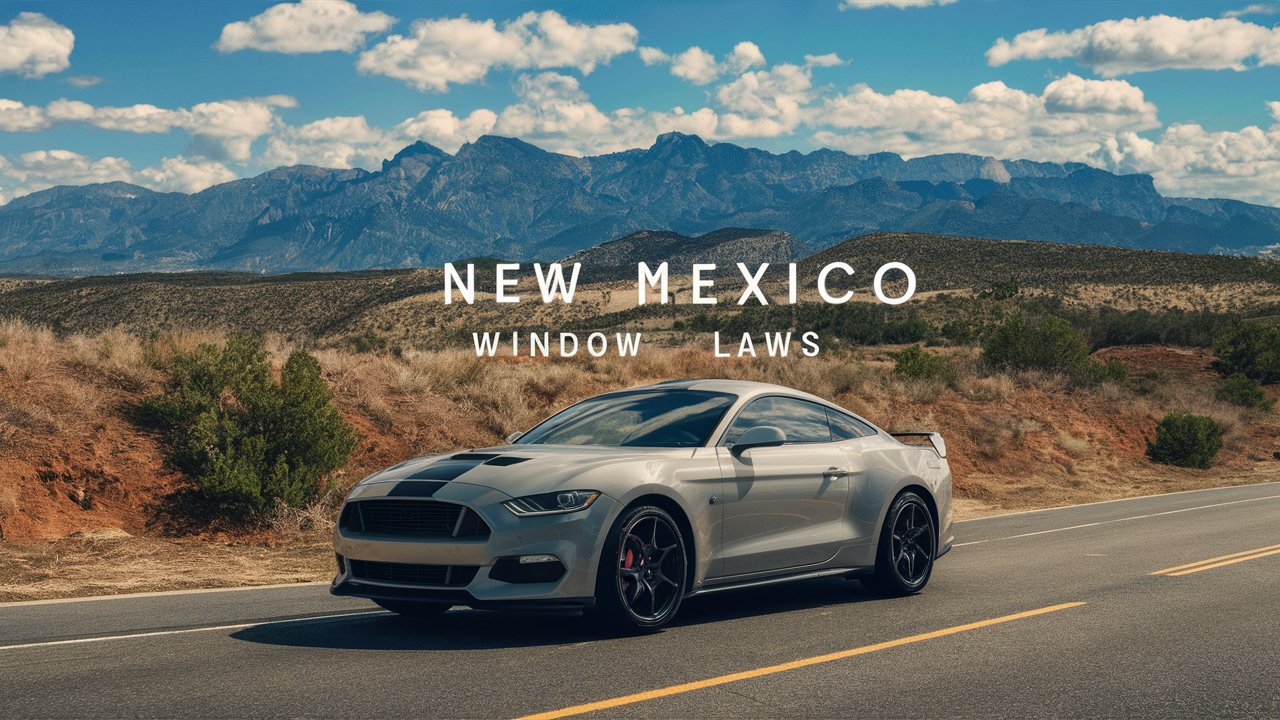Imagine your car’s windows as a delicate balance between privacy and visibility.
In New Mexico, this balance is meticulously regulated by specific window tinting laws.
For sedans, side windows must allow at least 20% light transmission, while SUVs and vans have slightly different stipulations.
Reflective tints are a no-go on front and back windows for sedans, ensuring that safety isn’t compromised.
But did you know there’s a special rule for the top 5 inches of your windshield?
And what about those with medical conditions? Let’s explore how these laws could impact you.
Window Tint Darkness in New Mexico
When it comes to window tint darkness in New Mexico, you’ll need to account for different rules for sedans, SUVs, and vans.
For sedans, the side windows must allow at least 20% light transmission, ensuring visibility, while the rear window tint must be non-reflective.
Meanwhile, SUVs and vans have varying regulations, so it’s important to be aware of the specific requirements for each vehicle type to avoid fines.
Tint darkness for sedans:
Understanding the regulations for window tint darkness on sedans in New Mexico is crucial for ensuring compliance and road safety.
When it comes to window tint in New Mexico, sedans must adhere to specific guidelines regarding tint darkness.
The visible light transmission (VLT) is a key factor here, dictating how much light must pass through the tint.
For sedans, the tint on the front, back, and rear windows must allow over 20% light penetration, ensuring that the vehicle remains visible and safe for all road users.
In addition to the VLT requirements, it is essential to mention that non-reflective tint is permitted only on the top 5 inches of the windshield.
This regulation helps to reduce glare while driving without compromising visibility.
Reflective tint, however, is not allowed on the front or back windows of sedans.
This rule is in place to avoid creating blinding reflections that could endanger other drivers on the road.
Tint darkness for SUV and Vans:
- Windshield: Reflective or mirrored tint is not permitted on the windshield.
- Front Side windows: Must allow more than 20% of light in.
- Back Side windows: Any shade can be used.
- Rear window: Any shade can be used.
Window Tint Reflection in New Mexico
When it comes to window tint reflection in New Mexico, you’ll find that sedans aren’t subject to specific restrictions.
However, if you drive an SUV or van, reflective tint on both the front and back windows is not allowed.
Understanding these distinctions helps guarantee you comply with state regulations.
Tint reflection for sedans:
- Front windows: Reflective tint is prohibited on sedan front windows in New Mexico.
- Back windows: Reflective tint is also prohibited on sedan back windows in New Mexico.
- Safety: Using non-reflective tint is required to ensure clear visibility and reduce the risk of glare for all drivers on the road.
- Enforcement: Law enforcement officials strictly enforce these regulations to maintain road safety standards.
- Compliance: Adhering to non-reflective tint rules is crucial to avoid penalties and ensure vehicle safety.
- Driving Environment: Following these guidelines contributes to creating a safer driving environment for all road users.
Tint reflection for SUV and vans:
- Front windows of SUVs and vans: Reflective shading is not allowed.
- Back windows of SUVs and vans: Reflective shading is not allowed.
Other New Mexico window tint rules and regulations
- Side Mirrors: No restrictions.
- Restricted Colors: In New Mexico, all tint colors are permitted.
- Certificates: Manufacturers of film need to certify the film they sell in the state. Ensure that the tint being used is certified.
- Stickers: A sticker/label of compliance to identify legal tinting is required between the film and glass on each tinted window.
- Medical Exceptions: New Mexico allows for medical exemptions for special tint. For specific terms of the exemption, refer to state law.
- Penalties: Violating window tint regulations in New Mexico can result in fines. It’s important to comply with the rules to avoid potential penalties.

Medical Exemptions for Window Tint Rules in New Mexico
For those with certain medical conditions, New Mexico allows window tint exemptions provided you have a signed document from a physician or optometrist.
This exemption is crucial for individuals who need darker window tint due to specific health issues.
To qualify for a medical exemption, you must obtain a signed document from a certified physician or optometrist, outlining the necessity for the increased tint darkness.
In New Mexico, this medical exemption documentation must be kept in your vehicle at all times to avoid penalties for non-compliant tint.
If you’re a legal guardian, you can hold this document on behalf of the individual with the medical condition, guaranteeing that the vehicle remains compliant with the state’s regulations.
The New Mexico statutes provide clear guidelines for these medical exemptions, specifying the acceptable levels of tint darkness for exempted vehicles.
Possessing an exemption document not only grants you the right to darker window tint but also helps law enforcement quickly verify your compliance with the state’s window tint laws.
By following these guidelines, you can secure your vehicle remains within legal tint limits while accommodating your medical needs.
New Mexico Window Tint Ticket Cost
The cost of a ticket for violating New Mexico’s window tint laws is $75. If you’re driving with a tint that’s too dark or too reflective, you might face this fine.
New Mexico enforces strict guidelines on window tint darkness and reflectivity, so understanding these rules is necessary to avoid penalties.
When you receive a ticket for a window tint violation, you’re not just dealing with the $75 fine.
There may be additional legal consequences, such as mandatory tint removal.
This means you could incur extra costs for removing and replacing the non-compliant tint with one that meets New Mexico’s standards.
Moreover, repeatedly ignoring these regulations can lead to further penalties, which might include higher fines or even legal action.
It’s vital to ensure your vehicle’s window tint complies with state laws to avoid these issues.
Knowing and following New Mexico’s window tint laws helps you steer clear of costly tickets and keeps your vehicle legally compliant on the road.
New Mexico Overview and Demographics
New Mexico, with a population of around 2.1 million people spread over 121,589 square miles, has unique population density trends that reflect its urban and rural mix.
The state’s cultural diversity, highlighted by Native American, Hispanic, and Anglo influences, is a significant aspect of its identity.
Additionally, New Mexico’s economy is supported by key industries such as oil and gas, tourism, and agriculture, which play vital roles in its economic activity.
Population Density Trends
Understanding New Mexico’s population density reveals a state where vast landscapes and cultural diversity coexist with remarkably low urban concentrations.
With approximately 17 people per square mile, New Mexico stands as one of the least densely populated states in the U.S.
Despite its expansive land, the total population hovers around 2.1 million, mainly settled in urban areas like Albuquerque and Santa Fe.
When considering New Mexico’s Window Tint Laws, taking into account the state’s unique population density is crucial. Urban areas, despite their relative concentration, still maintain a sense of spaciousness.
This can influence how residents perceive and use tint in New Mexico, balancing the need for privacy and protection from the sun with the state’s vast open spaces.
The slow population growth rate contributes to New Mexico’s emphasis on preserving natural landscapes and cultural heritage.
Rural areas, characterized by vast deserts and mountains, have even lower population densities.
This demographic makeup, including a significant Hispanic and Native American presence, shapes the state’s identity.
Understanding these trends helps you appreciate how the environment and population density can influence daily life and regulations in New Mexico.
Cultural Diversity Highlights
Amidst a backdrop of stunning landscapes, New Mexico boasts a rich cultural tapestry woven from Native American, Hispanic, and Anglo influences.
This blend is evident in the state’s demographics, with approximately 48% of the population identifying as Hispanic, 37% as non-Hispanic White, and 10% as Native American.
This cultural diversity is celebrated through a multitude of traditional arts, cuisines, music, and festivals that occur throughout the state.
When you explore New Mexico, you’ll notice the unique architecture, traditions, and languages that reflect this vibrant mix of cultures.
The blend of Native American, Spanish, and Anglo cultures creates a community that is inclusive and full of distinctive customs and traditions.
These cultural elements are not only a source of pride but also contribute to the state’s rich heritage.
As you drive through New Mexico, the state’s window tinting laws ensure you can enjoy these cultural sights.
For instance, side windows must allow more than 20% of light into the vehicle, while the rear window must allow more than 20% as well.
This balance allows you to experience the stunning cultural and natural landscapes New Mexico offers.
Economic Activity Overview
While you’re immersing yourself in the cultural richness of New Mexico, it’s also worth noting that the state boasts a diverse and dynamic economy.
The economic activity in New Mexico spans several key industries, including oil and gas, tourism, agriculture, government, and healthcare. In 2020, the state’s GDP was $95.7 billion, and the per capita personal income stood at $45,465.
Major employers like Los Alamos National Laboratory, Sandia National Laboratories, and the University of New Mexico contribute significantly to the job market.
The state’s unemployment rate was 8.2% in August 2021, which was slightly higher than the national average.
New Mexico’s economic development initiatives are focused on renewable energy, aerospace, and film production to stimulate growth and create new job opportunities.
These initiatives aim to diversify the economy further and reduce unemployment rates.
When considering the state’s window tinting laws, it’s crucial to understand how these regulations fit into the broader economic context.
The laws are designed to balance public safety, energy efficiency, and aesthetic preferences, reflecting the state’s commitment to fostering a business-friendly environment while ensuring community well-being.
The economic activity in New Mexico supports a balanced approach to regulation, benefiting both residents and businesses.
References
New Mexico Statutes section 66-3-846.1: Sun screening material on windshields and windows
Frequently Asked Questions
What Is the Darkest Legal Tint in New Mexico?
When considering tint darkness for your car, safety and legal limits are important.
Make sure your window tint allows more than 20% light for visibility. Remember, car modifications must adhere to regulations to avoid enforcement issues.
What Are the Tint Laws in New Mexico 2024?
Imagine driving with sunglasses at night. In 2024, New Mexico’s tint percentage limits require side and rear windows to allow 20% light transmission.
Enforcement procedures guarantee safety regulations maintain visibility, so everyone feels safe on the road.
How Do I Get a Tint Exemption in New Mexico?
To get a tint exemption, you need a physician’s note detailing the medical conditions requiring it.
Carry this document in your vehicle to meet legal requirements. This exemption lets you make necessary vehicle modifications for health reasons.
What Is the Darkest Tint That Is Legal?
The darkest legal tint you can have is 20% VLT for side windows and rear windshield. For visibility and safety concerns, enforcement includes fines.
Exemptions for medical reasons exist, but you must comply with legal limits.
Conclusion
Understanding and following New Mexico’s window tinting laws is crucial for every vehicle owner.
Picture your car’s windows as a pair of sunglasses; just as you wouldn’t want them overly dark to see through, your car’s tint must permit sufficient light for safety and visibility.
Abiding by these regulations helps you steer clear of fines, uphold unobstructed sightlines, and remain within lawful boundaries, promoting safer driving conditions for all on the road.
